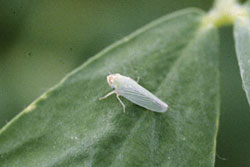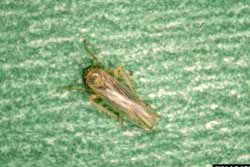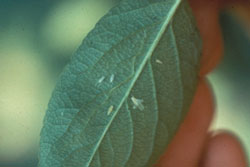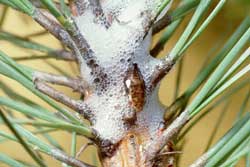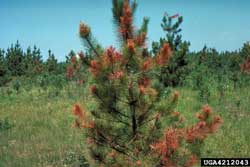Leafhoppers and Spittlebugs
Leafhoppers (Cicadellidae)
Leafhoppers are one of the largest families of plant-feeding insects. There are more leafhopper species worldwide than all species of birds, mammals, reptiles, and amphibians combined. Each species attacks specific host plants. As a group they feed on leaves of a wide variety of plants including many types of grasses, flowers, vegetables, fruit trees, shrubs, deciduous trees, and weeds.
Several leafhopper species are important agricultural pests, primarily because they are vectors of plant pathogens.
Spittlebugs (Cercopidae)
There are many species of spittlebugs that feed on conifers and broad-leaved ornamentals. Most are unsightly but do little damage to the plants. Two species, the pine spittlebug and the Saratoga spittlebug, are considered serious pests in Maine. Heavy infestations cause flagging branches, dead terminal growth, and stunted and distorted stems and branches, and will kill trees in two to three years.
Leafhopper/Spittlebug Comparison
Leafhoppers and spittlebugs are related and also look like each other. Leafhoppers are usually not more than 1/4 inch in length and narrower. Spittlebugs are generally a bit larger and more plump. Leafhoppers have at least one row of small spines along the hind tibia, where spittlebugs only have a few spines in this location. A most notable difference is that spittlebug nymphs make a foam and hide and feed inside it.
Leafhopper adults are elongated, wedge shaped and somewhat triangular in cross-section. They jump and fly off readily. Whiile generally not more than 1/4 inch in length, depending on species, they can range in size from 1/8 to 1/2 inch, and their bodies are colored yellow, green, gray or they may be marked with color patterns; they may be brightly colored or similar in color to the host plant. Nymphs resemble adults but are wingless. They can run rapidly, occasionally sideways, and hop.
Click on images to view full-size
Identification and Control Information
- Insect Pests of the Home Garden Series Fact Sheet: Leafhoppers (PDF)—Rutgers Cooperative Research & Extension
- Sucking Insects That Affect Vegetable Plants—University of Maine Cooperative Extension
- Insects of Vegetables: Potato Leafhopper (PDF)—Cornell University, New York State Cooperative Extension
- Potato Leafhopper—Penn State, Department of Entomology
- Integrated Pest Management: Potato Leafhopper—University of Connecticut
- Vegetable Program Insect Management: Potato Leafhopper—UMassAmherst
- Fact Sheet: Aster Leafhopper (PDF)—University of Wisconsin Extension
- Fact Sheet: Aster Leafhopper—University of Minnesota, Department of Entomology
- The Aster Leafhopper and Aster Yellows—Ontario Ministry of Agriculture Food & Rural Affairs
- Rose Insects & Related Pests (PDF)—Clemson Cooperative Extension
- White Apple Leafhopper—Washington State University
- Spittlebugs—Clemson University Extension
- Saratoga Spittlebug—Maine Forest Service
- Pests of Trees and Shrubs: Spittlebugs (PDF)—IPM of Midwest Landscapes
- Spittlebugs on Plants in Landscape—Purdue Plant & Pest Diagnostic Laboratory
- Leafhoppers & Spittlebugs—Washington State University
[Photos, left to right: Steve L. Brown, University of Georgia, Bugwood.org; Whitney Cranshaw, Colorado State University, Bugwood.org; University of Georgia Plant Pathology Archive, University of Georgia, Bugwood.org; John H. Ghent, USDA Forest Service, Bugwood.org; Clemson University - USDA Cooperative Extension Slide Series, Bugwood.org; Minnesota Department of Natural Resources Archive, Minnesota Department of Natural Resources, Bugwood.org]
